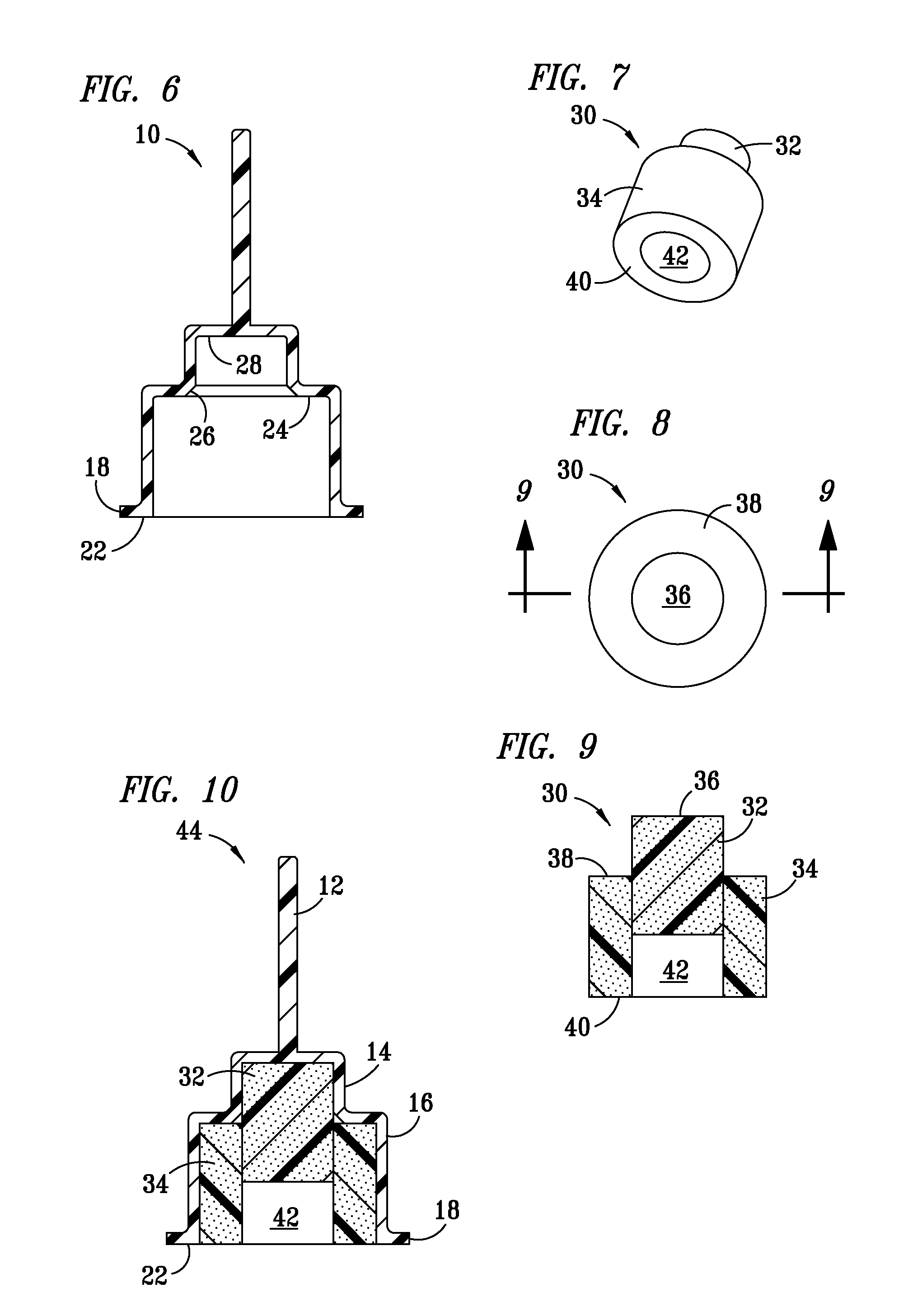[0011]According to at least one embodiment of the invention, the housing of the subject cleaning tool is molded, thermoformed or stamped from a suitable material, most preferably a polymeric material. A flexible insert such as a chemically treated
sponge is preferably disposed inside the housing and can further comprise a centrally disposed opening having interior side and end wall sections configured to receive and contact external portions of the free end of a frontal attachment as the cleaning tool is manipulated by a user. Where the flexible insert is a
sponge, the sponge desirably contains an amount of cleaner or
disinfectant and, optionally, one or more other additives, that is adequate for decontaminating the frontal attachment with which it is used. Both the housing and the sponge portion of the cleaning tool are desirably latex-free to avoid possible allergic reactions with either the user or a patient.
[0013]According to at least one embodiment of the invention, a cleaning tool for attachment surfaces of fluid connector devices used in medical applications is provided that comprises a housing containing a flexible insert as described above, and has an attached polymeric
handle with flexible side walls, a closed end and a hollow interior cavity with an open end that is in fluid communication with the flexible insert. The frangible ampule or another similarly effective fluid reservoir is desirably disposed inside
handle and preferably contains an amount of cleaning and disinfecting fluid that is sufficient to partially saturate flexible insert and effectively clean and disinfect the exposed free end of a frontal attachment inserted into surrounding contact by the insert. A lever arm with a blunt edge is desirably provided on the outside of the
handle to facilitate the selective application of manual force against the side wall of handle, causing it to flex sufficiently to cause fracturing of the relatively rigid sidewalls of the ampule, thereby releasing cleaning and disinfecting fluid to flow downwardly by gravity into the flexible insert.
[0016]According to at least one embodiment of the invention, another tool is disclosed that can be used for both topical cleaning of
skin or an exposed surface, and for mechanically cleaning and / or applying fluid to attachment surfaces of fluid connector devices used in medical applications. The subject tool preferably comprises structural elements as described in
Paragraph 0012 above except that it desirably comprises only a single, liquid-absorbing, flexible foamed polymeric insert having a cylindrical base that is preferably heat-staked into the annular recess of the housing. The upwardly projecting portion of the insert preferably further comprises a slit or recess to facilitate use as a cleaning tool for attachment surfaces of fluid connector devices used in medical applications. Prior to sealing, the insert projects upwardly past the otherwise open end of the housing. Prior to heat-
staking, a cleaning and / or disinfecting liquid is desirably introduced into the housing. After attachment of the insert to the annular recess of the housing, the flexible foam insert is desirably compressed inside the housing and the web is releasably sealed to the
flange to cover the opening and maintain the insert in its compressed state pending use. When the web is later removed just prior to use, and the insert is substantially saturated with the cleaning liquid, the insert expands to its projecting position to facilitate use as a topical cleaning or disinfecting tool. The slit or recess in the upwardly facing portion of the insert can receive at least a portion of the attachment surfaces of a fluid connector or outer surfaces of another device, and the upwardly projecting portion of the insert can be forced back down inside the housing, where the sidewalls provide resistance and facilitate scrubbing the attachment surfaces.
[0019]During use of this embodiment of the invention, the subject cleaning tool is desirably inverted prior to removing the liquid seal so that the cleaning liquid can saturate the sponge. When the seal is removed from the cleaning tool, the forwardly extending tip of a device to be cleaned is desirably inserted into the housing against the sponge. As the forwardly extending tip of the device approaches the positioning collar, the sponge partially collapses around the side of the device being cleaned and moves toward the center of the tool. As the tip of the device being cleaned is forced through the aperture of the positioning collar, the sponge is further squeezed around the device, at which time rotation of the cleaning tool relative to the device will cause the sponge to scrub both the end and sides of the portion disposed inside the tool. Further movement of the tip into the housing can cause the sponge to pass through the aperture of the positioning collar into a position behind the collar, where the sponge is no longer diametrically constrained by the collar. Upon withdrawal of the device from the cleaning tool, the sponge is largely or totally retained inside the closed end of the housing by the positioning collar, preventing any further
contamination by possible contact between the “dirty” sponge and the hands of the user.
 Login to View More
Login to View More  Login to View More
Login to View More 


